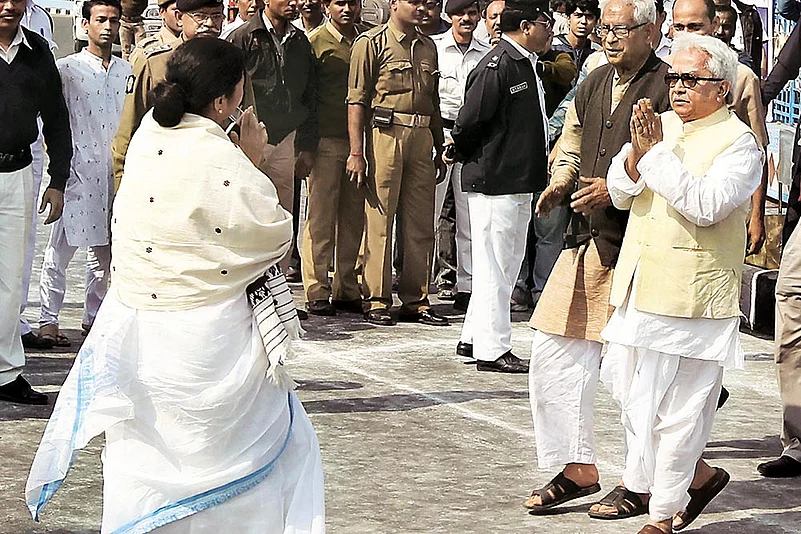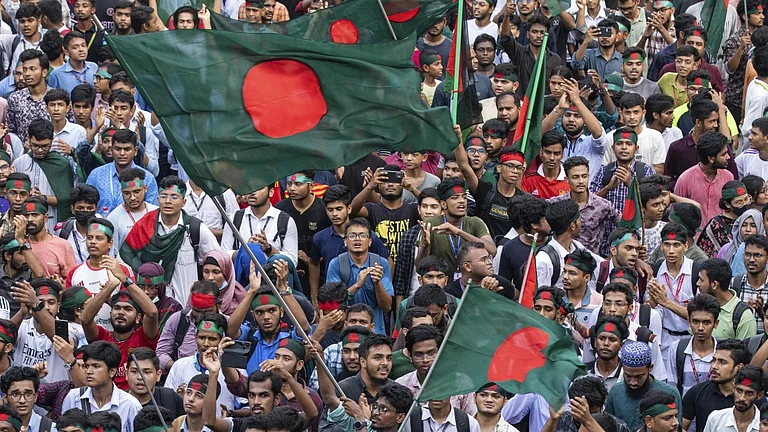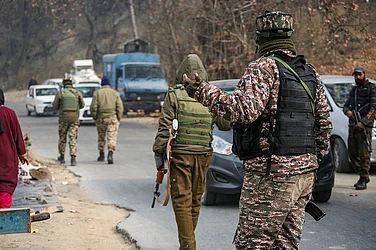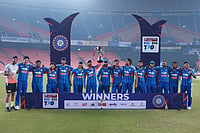It is unusual for chief ministers to meet each other bilaterally to discuss national political developments. Mostly, their interactions are restricted to events in New Delhi, convened by the Union government. On the rare occasion when they take place, they are restricted to thrashing out thorny, sticky issues and to help put relations back on track.
However, such a truism doesn’t apply to Mamata Banerjee. Over the past eight years and since coming to power in 2011, the West Bengal chief minister has been either busy meeting or in getting in touch with her counterparts from Tamil Nadu (J. Jayalalitha), Uttar Pradesh (Mulayam Singh Yadav), Delhi (Arvind Kejriwal), Bihar (both Laloo Prasad Yadav and Nitish Kumar) and Orissa (Naveen Patnaik).
Her efforts had begun before 2014, but since Narendra Modi led the BJP to an emphatic victory at the Centre, they have been pursued with periodic intensity. The objective of all the confabulations has been to forge a coalition of anti-BJP forces to counter a rising tide of right-wing influence.
“Arguably, Mamata is one of the pioneers of the discussion that now centres on the formation of a federal front in the current political scenario,” says veteran political commentator Tarun Ganguly.
The interest around the March 19 meeting in Calcutta between K. Chandrasekhara Rao and Mamata Banerjee, therefore, is understandable. It takes place at a time when regional political supremos have begun to position themselves yet again to deal with the emerging political landscape before the 2019 Lok Sabha elections. The recent bypolls in UP, where non-BJP parties came together to deal it a bitter blow, have added significance to the move. For the Trinamool Congress, given the BJP’s increasing presence in the neighbouring Northeast and its stunning victory in Tripura, a vantage point from where they audaciously declared their intention to grab power in Bengal, such talks have assumed extra piquancy. The meeting at Nabanna, the state secretariat building, between the Telangana CM and his West Bengal counterpart, sparked off speculation about Mamata’s much-touted ‘federal front’, its possible constituents and its viability. And the arc is widening—next week Mamata is embarking on a four-day trip to Delhi, to take part in a meeting of opposition parties called by NCP chief Sharad Pawar. The contours of the front would be discussed threadbare, and possible participants wooed.
But before this, a front-page opinion piece of the March 5 edition of Bengali daily Aajkaal drew the notice of political observers in Calcutta. In Tripura’s Lesson, Devesh Roy, a Bengali writer and TMC-leaning intellectual, argued that it was time for all democratic and secular forces to come together and launch a movement under Mamata’s leadership against the BJP. The slogan, suggested Roy, should be ‘oust BJP’ from West Bengal. Coordination among like-minded political forces, he exhorted, should ensure that the BJP is denied even a single seat in any state poll, starting with the impending panchayat polls. Interestingly, Roy was among the first intellectuals to criticise the Left’s role in Singur and Nandigram in 2007-2008 and said that it was Mamata who had replaced the Communists as the new champion of Bengal’s downtrodden. The piece is being seen as an attempt to build opinion towards building a broad anti-BJP force in the state.
Though Roy did not name the parties he wanted to unite under Mamata’s leadership to fight the BJP, many read it as a proxy appeal to the Left, especially the CPI(M). The fact that Roy’s column and Mamata’s public criticism of the attack on the Lenin statue by BJP hoodlums in Tripura came almost simultaneously was seen as a renewed overture being made by the TMC leader to the Left.
Mamata had made an unsuccessful attempt in 2014 to woo the Left parties and make them partners in her fight against Narendra Modi’s BJP. Her meeting with Biman Bose, the then CPI(M) state secretary, and other Left Front leaders did not go down well with Left party cadres. There was outrage in the CPI(M) rank-and-file that while most of their comrades in Bengal were being thrashed and their party offices and houses ruthlessly attacked by TMC goons, the top brass were discussing the threat from the BJP over cups of tea and hot fish cutlets.

Telangana CM K. Chandrasekhara Rao meets Mamata Banerjee in Calcutta
“I have kept options open. No one is politically untouchable. If the opportunity comes we will consider an alliance,” Mamata had sagely commented then to the Bengali news channel 24 Ghanta.
Brushing aside the CPI(M) cadres’ opposition to her overture, the TMC leader had subsequently tried to reach out to CPI(M) politburo member Sitaram Yechury, ostensibly to discuss ‘floor coordination’ on an important issue in Parliament against the Modi government.
Indeed, the Bengal CM had at that time declared that she was not averse to tying up with the Left in order to fight the right-wing threat issuing from the BJP. Recalling the overtures from Mamata, whose rise to power was at the expense of the CPI(M), Ganguly points out, “It was being called a political earthquake. But she had a precedent in diehard rivals Laloo Prasad Yadav and Nitish Kumar joining hands to fight the BJP, and more so because that alliance was a winner”.
Could arch-enemies, the Left and the Trinamool, really unite to take on a more immediate threat?
“It is completely out of the question,” says CPI(M) MP Mohammed Salim. He points out that the Trinamool and the BJP make public declarations about their rivalry, but eventually back each other when it comes to the crunch. “Mamata Banerjee has time and again proved that she is not a reliable, trustworthy partner,” he adds.
Salim reflects the prevailing mood—the majority of the state CPI(M) favours an alliance with the Congress in a face-off with the BJP. That their cadre-based ground organisation has been under constant, merciless attack from the TMC is also a factor. Then, too, as a Congress leader from Bengal early in her career too, Mamata was known for her unremitting hostility to the CPI(M). No wonder, the resolution passed in the recently concluded CPI(M) state conference dubbed both TMC and BJP as forces that pose serious challenges for the party.

Though Mamata tried to encash on the rising sense of outrage after the vandalisation of Lenin’s statue in Tripura, TMC stormtroopers had been doing the same thing in Bengal to CPI(M) cadres and party offices. “They had not spared a single statue and picture of our leaders when they ransacked our party offices,” laments a CPI(M) activist. “Is there any point of taking her seriously when she condemns the BJP’s attack on Lenin’s statue and our party office in Tripura?”
Referring to the tie-up in the 1998 and 1999 Lok Sabha polls between the TMC and the BJP, CPI(M) leader Surya Kanta Mishra says, “It was Mamata Banerjee who brought the BJP to Bengal.” It’s strange, though, that despite being cut dead, so to say, by the CPI(M), Mamata should be still harbouring hopes of reaching an understanding with them. Seemingly in absolute control in the state, what is driving Mamata to look for an alliance with the Left?
According to her political calculations, the political irrelevance of the Left in Bengal means that the 20-23 per cent of the voteshare it still commands could move to BJP in future. The Left’s marginalisation would itself aid the BJP’s prominence and its recognition as the only viable force to fight the ruling TMC. On the other hand, a division of the anti-TMC votes among the Left, Congress and BJP is a check on Hindutva forces. As long as it remains one among opposition parties, the BJP will have to fight for anti-TMC votes with the Left and the Congress. For this to be accomplished, of course, the other two will have to stay in contention as independent opposing parties with only a tacit alliance with the TMC.
Though spurning a TMC olive branch, the CPI(M) is also alarmed at the BJP’s rapid rise and is desperately looking at an alliance with the Congress to counter it. The Congress, and not the aggressive TMC, suits them as an ideal partner to combat the saffron surge.
For now, keeping Bengal under the heels of the TMC is important for Mamata not only for the forthcoming panchayat elections. Rather, she sees these polls as a stepping stone to the greatest prize—winning all the 42 Lok Sabha seats in Bengal at the 2019 parliamentary elections.
That full score will increase Mamata’s weight in her proposed federal front with like-minded secular and democratic forces. Along with that, if she is able to forge a broad coalition in Bengal, it will propel her as a key player at the national level. Depending on what numbers the BJP and the anti-Hindutva alliance have in their respective kitties, it will allow Mamata a stronger hand to bargain with.
TMC leaders are, understandably, reluctant to talk about the emerging, nebulous scenario. “All we can say is that Mamata Banerjee pioneered the discussion on the formation of a federal front comprising democratic and secular forces,” says a source. The question of the Left’s being part of such a common anti-communal platform, or its acceptability to the TMC rank and file, is something that will take time to become clearer, says he.
As the months creep closer to 2019, the once desultory parleys will become hectic—promises will be extracted and final alliances forged. Those days of feverish activity are keenly awaited not only by the TMC, the Left and the Congress. The BJP, main claimant to power in Bengal, will be ready with its formidable drawing board.
By Dola Mitra and Pranay Sharma


























